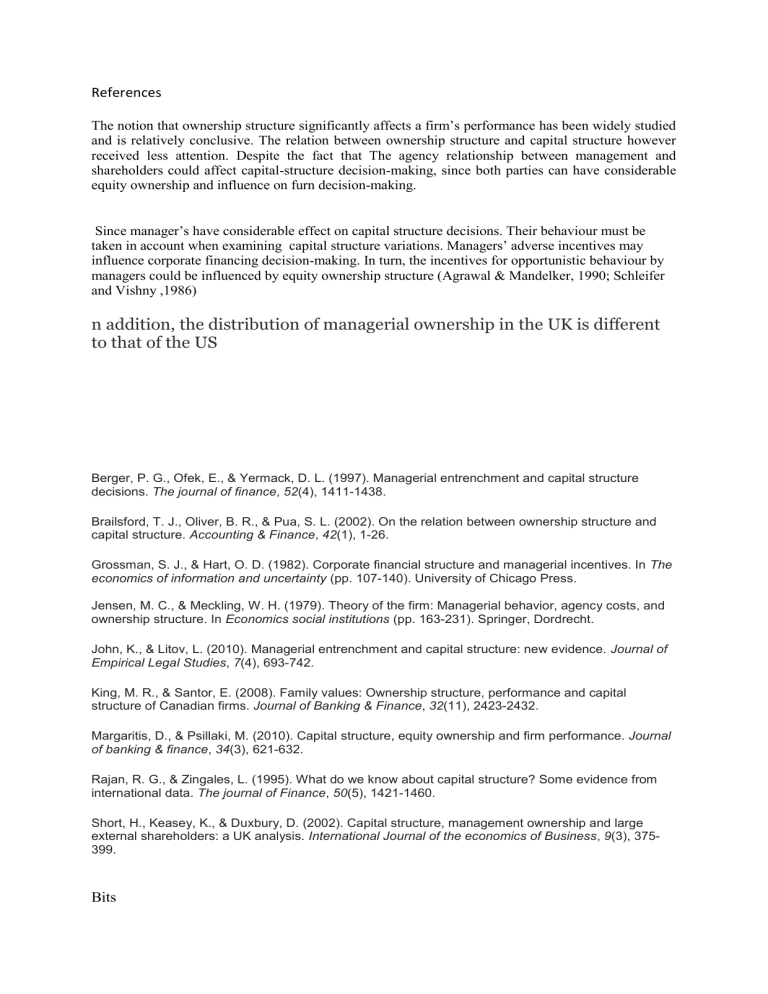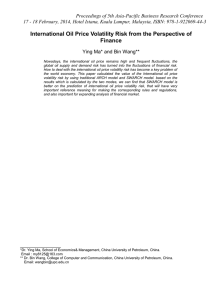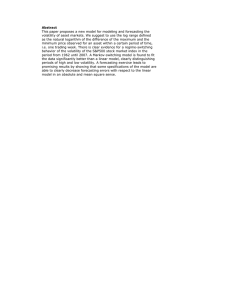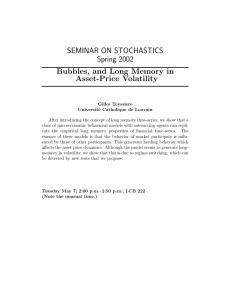
References The notion that ownership structure significantly affects a firm’s performance has been widely studied and is relatively conclusive. The relation between ownership structure and capital structure however received less attention. Despite the fact that The agency relationship between management and shareholders could affect capital-structure decision-making, since both parties can have considerable equity ownership and influence on furn decision-making. Since manager’s have considerable effect on capital structure decisions. Their behaviour must be taken in account when examining capital structure variations. Managers’ adverse incentives may influence corporate financing decision-making. In turn, the incentives for opportunistic behaviour by managers could be influenced by equity ownership structure (Agrawal & Mandelker, 1990; Schleifer and Vishny ,1986) n addition, the distribution of managerial ownership in the UK is different to that of the US Berger, P. G., Ofek, E., & Yermack, D. L. (1997). Managerial entrenchment and capital structure decisions. The journal of finance, 52(4), 1411-1438. Brailsford, T. J., Oliver, B. R., & Pua, S. L. (2002). On the relation between ownership structure and capital structure. Accounting & Finance, 42(1), 1-26. Grossman, S. J., & Hart, O. D. (1982). Corporate financial structure and managerial incentives. In The economics of information and uncertainty (pp. 107-140). University of Chicago Press. Jensen, M. C., & Meckling, W. H. (1979). Theory of the firm: Managerial behavior, agency costs, and ownership structure. In Economics social institutions (pp. 163-231). Springer, Dordrecht. John, K., & Litov, L. (2010). Managerial entrenchment and capital structure: new evidence. Journal of Empirical Legal Studies, 7(4), 693-742. King, M. R., & Santor, E. (2008). Family values: Ownership structure, performance and capital structure of Canadian firms. Journal of Banking & Finance, 32(11), 2423-2432. Margaritis, D., & Psillaki, M. (2010). Capital structure, equity ownership and firm performance. Journal of banking & finance, 34(3), 621-632. Rajan, R. G., & Zingales, L. (1995). What do we know about capital structure? Some evidence from international data. The journal of Finance, 50(5), 1421-1460. Short, H., Keasey, K., & Duxbury, D. (2002). Capital structure, management ownership and large external shareholders: a UK analysis. International Journal of the economics of Business, 9(3), 375399. Bits Reviewing the influence of ownership structure on the corporate capital structure for as well ownership concentration as the predominant ownership identities has not been done after the 2008 credit crisis. Since the effects of the 2008 recession where felt globally and many changes had to be made in corporate finance in order to survive. Where changing corporate finance strategies creates a suspicion of a change in the relationship between ownership structure and the corporate financial structure, this research investigates if this relationship has been altered and provides an updated view on the matter (1) the cor- poration finance specialist concerned with the techniques of financing firms so as to ensure their survival and growth; (2) the managerial economist concerned with capital budgeting; and (3) the economic theorist concerned with explaining investment behavior at both the micro and macro levels.' We contribute to this debate by revisiting the question of family ownership, firm performance, and capital structure using a unique panel data set of 613 Canadian firms from 1998 to 2005. Canada provides an ideal setting for studying this question, as it features more concentrated corporate ownership than the United States and more prevalent use of multiple classes of voting shares and pyramidal structures (Attig 2005; Morck, Stangeland and Yeung 2000). While the ownership structure is quite different between Canada and the United States, these two countrie The purpose of this paper is to examine the relationship between debt, management ownership and large external shareholders for a sample of UK quoted firms. Whilst a number of previous papers have examined the effects of ownership on the capital structure of the firm (for example, Kim and Sorenson, 1986; Friend and Lang, 1988; Jensen et al., 1992; Bathala et al., 1994; Firth, 1995, Berger et al., 1997), contradictory findings with respect to the relationship between debt and management ownership, and the relationship between debt and large external shareholders have been reported. Moreover, with the exception of Firth (1995), previous research has not investigated the interactions between debt, management 1 ownership and external shareholders . In addition, all previous studies focus on US firm data. This paper, therefore, extends the analysis of ownership and capital structure to UK firms and furthermore, it explicitly considers the interactions between management ownership and large external shareholders with respect to the capital structure of the firm. Modern corporations are characterized by a separation of ownership and control (Berle & Means, 1932). A range of literature has been done written on the effects of ownership and control on a company's operations. This also includes research on the relationship between ownership and capital structure. These studies studies have especially focused on the effects of managerial or external blockholder ownership separately. We will discuss both in the following chapters According to portfolio theory investors prefer a well-diversified portfolio to minimize their risk. Corporate managers do not have the capacity to diversify their investment and thus minimize risk. Their wealth is mostly derived from their non-diversifiable human capital which is invested in their employer firm. Since this affects the wealth of managers, they may have the incentive to reduce this employment risk by ensuring the viability of the company. One way to lower their non-diversifiable employment risk is to decrease the company's debt-ratio. This will lower the chances that the firm goes bankrupt which in turn will decrease the risk of unemployment for management. Thus ensuring their employment and future earnings. The flipside is that managers therefore have the incentive to decrease leverage to a point to it may be sub-optimal. Corporate governance mechanisms are in place to discipline and control managers behaviour. Thus, at low managerial ownership incentives alignment may lead to lower agency cost of debt which results in higher leverage. However, managers become entrenched after a certain point, which increase the incentives to lower debt-ratios to reduce their undiversifiable risk. Hence, the non-linear inverted Ushape with positive correlation at lower levels of ownership and a negative correlation at higher levels. This shape was also found in their empirical study of Australian firms. The found critical point was at the level of 49% managerial ownership. Author(s) Country Latane and Rendleman (1976) Chiras and Manaster (1987) WISD, dividend adjusted BlackScholes model. Beckers (1981) WISD, at-the money implied volatility Day and Lewis (1992) Time-series behavior of at-themoney implied volatility with GARCH. Stochastic volatility option pricing model (Hull and White, 1987) with GARCH volatility estimates Lamoureux and Lastrapes (1993) Canina and Figlewski (1993) Time-series behavior of at-themoney implied volatility Period WISD outperforms historical volatility in predicting realized stock volatility WISD superior in predicting realized stock volatility, 32% of realized stock volatility is forecasted Observation s Crosssectional correlations Managerial ownership Crosssectional OLS regressions CBEO individual stock options for the period 06/197303/1975 62-115 CBEO stock options for the period 04/197306/1977 All implied volatility measures better in forecasting crosssectional realized stock volatility than monthly historical volatility. However implied volatility is biased and informationally inefficient Implied volatility is an informationally inefficient predictor of realized stock volatility Implied volatility is an informative but biased predictor. Historical volatility however contains additional information of realized stock volatility Crosssectional correlation Implied volatility from options with different moneyness and maturities show nog significant Time series, OLS regression realized stock Time series, OLS regression Time series, OLS regression S&P 100 index options 11/198312/1989 At-themoney CBOE call options based on 10 non-dividend paying stocks for period 04/198203/1984 S&P 100 index call options for period relation with realized stock volatility. Historical volatility superior in forecasting realized stock volatility Implied volatility is informationally efficient and an unbiased forecast of realized volatility. Implied volatility was superior over historical and GARCH volatility measurements. volatility on implied volatility 03/198303/1987 Time series, OLS regression realized volatility on implied volatility Foreign currency futures options traded on the Chicago Mercantile Exchange (CME) for period 01/198502/1992 At-the money S&P 100 index call option from 11/1983 to 05/1995 35 futures options markets on 8 different exchanges Jorion (1995) Forecasting power of implied volatility by futures option prices. Christensen and Prabhala (1998) Investigating the forecasting power of implied volatility of realized stock volatility based on non-overlapping sampling procedure Implied volatility implied by future option prices Implied volatility is an efficient and unbiased predictor of realized stock volatility OLS regression, instrumenta l variables method Implied volatility is informationally efficient in future markets OLS regression, GARCH Christensen and Hansen (2002) Research examines the informational efficiency of call and put implied volatility separately Shu and Zhang (2003) Study examines the relationship between implied volatility and realized stock volatility with four different measures of realized volatility Call and put volatilities both efficient and unbiased predictor of realized stock volatility. Call slightly better predictor The results conclude that implied volatility is an informationally efficient but biased predictor of realized stock volatility OLS regression, full information maximum likelihood (FIML) OLS regression, instrumenta l variables method Szakmary et al (2003) 500 index options traded on the CBEO for the period 01/199512/1999 Examining the relationship between ownership and capital structure can provide insights into capital structure decision and contribute to the capital structure puzzle discussion that at low levels of managerial ownership, external block holders have an active role in monitoring and controlling management. This will result in less managerial opportunistic behaviour and thus lower agency costs. In this situation, managerial and external block ownership will both positively affect incentivizing managers. At low levels block ownership complements managerial ownership. At high levels of managerial ownership, To Other theoretical and empirical studies suggest negative relationship between management ownership and debt ratios. As management equity can also be considered as a disciplining measure which can align management incentives with shareholder interest. It may substitute debt as a discipling mechanism. Thus increasing management ownership, can reduce the need for debt as a disciplining measure. Furthermore, at higher levels of ownership, managers are unable to diversify their portfolio due to their invested human capital. Increasing the leverage may have negative effect on their employment and thus their wealth. Managers may therefore choose to reduce firm risk by lowering leverage which again indicates a negative relation between managerial ownership and leverage. Agrawal, A., & Knoeber, C. R. (1996). Firm performance and mechanisms to control agency problems between managers and shareholders. Journal of financial and quantitative analysis, 31(3), 377-397. Agrawal, A., & Mandelker, G. N. (1987). Managerial incentives and corporate investment and financing decisions. The journal of finance, 42(4), 823-837. Agrawal, A., & Nagarajan, N. J. (1990). Corporate capital structure, agency costs, and ownership control: The case of all‐equity firms. The Journal of Finance, 45(4), 1325-1331. Balakrishnan, S., & Fox, I. (1993). Asset specificity, firm heterogeneity and capital structure. Strategic Management Journal, 14(1), 3-16. Bathala, C. T., Moon, K. P., & Rao, R. P. (1994). Managerial ownership, debt policy, and the impact of institutional holdings: An agency perspective. Financial Management, 38-50. Berger, P. G., Ofek, E., & Yermack, D. L. (1997). Managerial entrenchment and capital structure decisions. The journal of finance, 52(4), 1411-1438. Berle, A. A., & Means, G. C. (1932). The modern corporation and private property. New Brunswick. NJ: Transaction. Brailsford, T. J., Oliver, B. R., & Pua, S. L. (2002). On the relation between ownership structure and capital structure. Accounting & Finance, 42(1), 1-26. Brealey, R., Leland, H. E., & Pyle, D. H. (1977). Informational asymmetries, financial structure, and financial intermediation. The journal of Finance, 32(2), 371-387. DeAngelo, H., & Masulis, R. W. (1980). Optimal capital structure under corporate and personal taxation. Journal of financial economics, 8(1), 3-29. Firth, M. (1995). The impact of institutional stockholders and managerial interests on the capital structure of firms. Managerial and Decision Economics, 16(2), 167-175. Friend, I., & Hasbrouck, J. (1988). Determinants of Capital Structure,'in Andy Chen ed. Research in Finance, Vol. 7, pp. 1-19. and L. Lang, 1988. An Empirical Test the Impact of Managerial Self-interest on Corporate Capital Structure," Journal of Finance, 43, 271-281. Friend, I., & Lang, L. H. (1988). An empirical test of the impact of managerial self‐interest on corporate capital structure. the Journal of Finance, 43(2), 271-281. Grossman, S. J., & Hart, O. D. (1982). Corporate financial structure and managerial incentives. In The economics of information and uncertainty (pp. 107-140). University of Chicago Press. Harris, M., & Raviv, A. (1988). Corporate control contests and capital structure. Journal of financial Economics, 20, 55-86. https://www.bloomberg.com/news/articles/2019-09-30/sanders-calls-for-taxes-on-exorbitantexecutive-compensation Jensen, G. R., Solberg, D. P., & Zorn, T. S. (1992). Simultaneous determination of insider ownership, debt, and dividend policies. Journal of Financial and Quantitative analysis, 27(2), 247-263. Jensen, M. C., & Meckling, W. H. (1976). Theory of the firm: Managerial behavior, agency costs, and ownership structure. In Economics social institutions (pp. 163-231). Springer, Dordrecht. Kim, W. S., & Sorensen, E. H. (1986). Evidence on the impact of the agency costs of debt on corporate debt policy. Journal of Financial and quantitative analysis, 21(2), 131-144. King, M. R., & Santor, E. (2008). Family values: Ownership structure, performance and capital structure of Canadian firms. Journal of Banking & Finance, 32(11), 2423-2432. Mehran, H. (1992). Executive incentive plans, corporate control, and capital structure. Journal of Financial and Quantitative analysis, 27(4), 539-560. Modigliani, F., & Miller, M. H. (1958). The cost of capital, corporation finance and the theory of investment. The American economic review, 48(3), 261-297. Moh'd, M. A., Perry, L. G., & Rimbey, J. N. (1998). The impact of ownership structure on corporate debt policy: A time‐series cross‐sectional analysis. Financial Review, 33(3), 85-98. Rajan, R. G., & Zingales, L. (1995). What do we know about capital structure? Some evidence from international data. The journal of Finance, 50(5), 1421-1460. Shleifer, A., & Vishny, R. W. (1989). Management entrenchment: The case of manager-specific investments. Journal of financial economics, 25(1), 123-139. Short, H., Keasey, K., & Duxbury, D. (2002). Capital structure, management ownership and large external shareholders: a UK analysis. International Journal of the economics of Business, 9(3), 375399. Stulz, R. (1988). Managerial control of voting rights: Financing policies and the market for corporate control. Journal of financial Economics, 20, 25-54. Zeckhauser, R. J., & Pound, J. (1990). Are large shareholders effective monitors? An investigation of share ownership and corporate performance. In Asymmetric information, corporate finance, and investment (pp. 149-180). University of Chicago Press.





